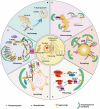Organelle-specific autophagy in inflammatory diseases: a potential therapeutic target underlying the quality control of multiple organelles
- PMID: 32048886
- PMCID: PMC8007140
- DOI: 10.1080/15548627.2020.1725377
Organelle-specific autophagy in inflammatory diseases: a potential therapeutic target underlying the quality control of multiple organelles
Abstract
The structural integrity and functional stability of organelles are prerequisites for the viability and responsiveness of cells. Dysfunction of multiple organelles is critically involved in the pathogenesis and progression of various diseases, such as chronic obstructive pulmonary disease, cardiovascular diseases, infection, and neurodegenerative diseases. In fact, those organelles synchronously present with evident structural derangement and aberrant function under exposure to different stimuli, which might accelerate the corruption of cells. Therefore, the quality control of multiple organelles is of great importance in maintaining the survival and function of cells and could be a potential therapeutic target for human diseases. Organelle-specific autophagy is one of the major subtypes of autophagy, selectively targeting different organelles for quality control. This type of autophagy includes mitophagy, pexophagy, reticulophagy (endoplasmic reticulum), ribophagy, lysophagy, and nucleophagy. These kinds of organelle-specific autophagy are reported to be beneficial for inflammatory disorders by eliminating damaged organelles and maintaining homeostasis. In this review, we summarized the recent findings and mechanisms covering different kinds of organelle-specific autophagy, as well as their involvement in various diseases, aiming to arouse concern about the significance of the quality control of multiple organelles in the treatment of inflammatory diseases.Abbreviations: ABCD3: ATP binding cassette subfamily D member 3; AD: Alzheimer disease; ALS: amyotrophic lateral sclerosis; AMBRA1: autophagy and beclin 1 regulator 1; AMPK: AMP-activated protein kinase; ARIH1: ariadne RBR E3 ubiquitin protein ligase 1; ATF: activating transcription factor; ATG: autophagy related; ATM: ATM serine/threonine kinase; BCL2: BCL2 apoptosis regulator; BCL2L11/BIM: BCL2 like 11; BCL2L13: BCL2 like 13; BECN1: beclin 1; BNIP3: BCL2 interacting protein 3; BNIP3L/NIX: BCL2 interacting protein 3 like; CALCOCO2/NDP52: calcium binding and coiled-coil domain 2; CANX: calnexin; CAT: catalase; CCPG1: cell cycle progression 1; CHDH: choline dehydrogenase; COPD: chronic obstructive pulmonary disease; CSE: cigarette smoke exposure; CTSD: cathepsin D; DDIT3/CHOP: DNA-damage inducible transcript 3; DISC1: DISC1 scaffold protein; DNM1L/DRP1: dynamin 1 like; EIF2AK3/PERK: eukaryotic translation initiation factor 2 alpha kinase 3; EIF2S1/eIF2α: eukaryotic translation initiation factor 2 alpha kinase 3; EMD: emerin; EPAS1/HIF-2α: endothelial PAS domain protein 1; ER: endoplasmic reticulum; ERAD: ER-associated degradation; ERN1/IRE1α: endoplasmic reticulum to nucleus signaling 1; FBXO27: F-box protein 27; FKBP8: FKBP prolyl isomerase 8; FTD: frontotemporal dementia; FUNDC1: FUN14 domain containing 1; G3BP1: G3BP stress granule assembly factor 1; GBA: glucocerebrosidase beta; HIF1A/HIF1: hypoxia inducible factor 1 subunit alpha; IMM: inner mitochondrial membrane; LCLAT1/ALCAT1: lysocardiolipin acyltransferase 1; LGALS3/Gal3: galectin 3; LIR: LC3-interacting region; LMNA: lamin A/C; LMNB1: lamin B1; LPS: lipopolysaccharide; MAPK8/JNK: mitogen-activated protein kinase 8; MAMs: mitochondria-associated membranes; MAP1LC3B/LC3B: microtubule-associated protein 1 light chain 3 beta; MFN1: mitofusin 1; MOD: multiple organelles dysfunction; MTPAP: mitochondrial poly(A) polymerase; MUL1: mitochondrial E3 ubiquitin protein ligase 1; NBR1: NBR1 autophagy cargo receptor; NLRP3: NLR family pyrin domain containing 3; NUFIP1: nuclear FMR1 interacting protein 1; OMM: outer mitochondrial membrane; OPTN: optineurin; PD: Parkinson disease; PARL: presenilin associated rhomboid like; PEX3: peroxisomal biogenesis factor 3; PGAM5: PGAM family member 5; PHB2: prohibitin 2; PINK1: PTEN induced putative kinase 1; PRKN: parkin RBR E3 ubiquitin protein ligase; RB1CC1/FIP200: RB1 inducible coiled-coil 1; RETREG1/FAM134B: reticulophagy regulator 1; RHOT1/MIRO1: ras homolog family member T1; RIPK3/RIP3: receptor interacting serine/threonine kinase 3; ROS: reactive oxygen species; RTN3: reticulon 3; SEC62: SEC62 homolog, preprotein translocation factor; SESN2: sestrin2; SIAH1: siah E3 ubiquitin protein ligase 1; SNCA: synuclein alpha; SNCAIP: synuclein alpha interacting protein; SQSTM1/p62: sequestosome 1; STING1: stimulator of interferon response cGAMP interactor 1; TAX1BP1: Tax1 binding protein 1; TBK1: TANK binding kinase 1; TFEB: transcription factor EB; TICAM1/TRIF: toll-like receptor adaptor molecule 1; TIMM23: translocase of inner mitochondrial membrane 23; TNKS: tankyrase; TOMM: translocase of the outer mitochondrial membrane; TRIM: tripartite motif containing; UCP2: uncoupling protein 2; ULK1: unc-51 like autophagy activating kinase; UPR: unfolded protein response; USP10: ubiquitin specific peptidase 10; VCP/p97: valosin containing protein; VDAC: voltage dependent anion channels; XIAP: X-linked inhibitor of apoptosis; ZNHIT3: zinc finger HIT-type containing 3.
Keywords: Lysophagy; mitophagy; nucleophagy; pexophagy; reticulophagy; ribophagy.
Conflict of interest statement
No potential conflict of interest was reported by the authors.
Figures


References
Publication types
MeSH terms
Substances
LinkOut - more resources
Full Text Sources
Research Materials
Miscellaneous
